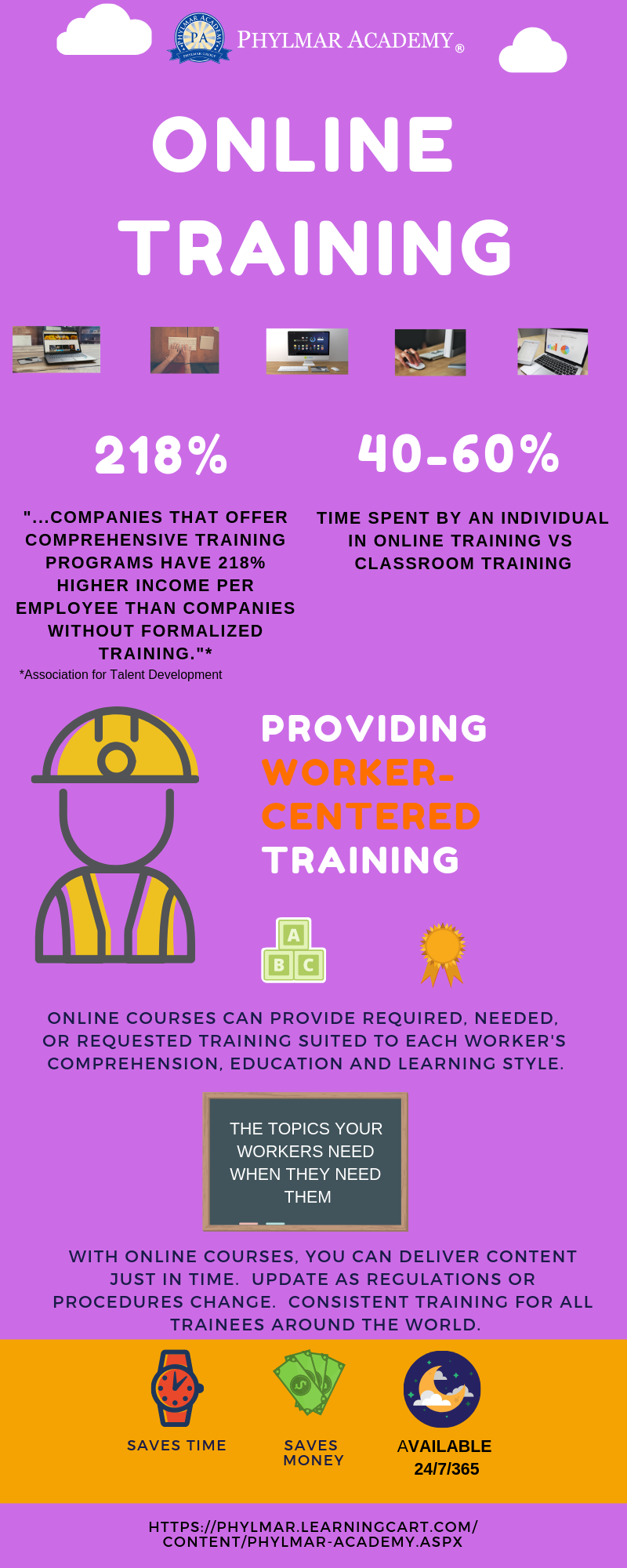By: Cass Ben-Levi
Your employees need health and safety training. What do you do? Call your HR Department, Safety Manager, or IT Department? Do you look online for off-the-shelf courses or create a customized online course suited to your needs?
In-person training is great. It’s what people are used to. It puts a human face on the training, allowing for, in fact encouraging, clarification from and interaction with a knowledgeable instructor. And for some companies, this is good enough.
Here are 10 reasons to consider online training:
- Cost-effectiveness. Online training stretches your training budget significantly. Whether you have your own staff of trainers or attend courses given by other organizations, the cost per person of any course is substantially lower with an online course. Consider the savings in:
- Enrollment fee
- Instructor upkeep
- Travel time to and from training location
- Time away from the job
- Whether onsite or offsite, in-person courses are scheduled through a combination of subject matter need, outside course or instructor availability, training room availability, trainee availability. The logistics of holding a course almost inevitably leaves some trainees out. They could be sick that day, working a different shift, have an emergency situation where they have to remain at work – it could be any number of obstacles. On the other hand, online courses are available 24/7/365.
- Self-Paced. Adults learn differently – some learn better from hearing, some from reading, some from doing. While in-person courses can address these different modes of learning, they often don’t. But online courses offer these advantages:
- Learn at your own rate – stop and start the course whenever you need or want to.
- Learn when and where you want – attend your online course at your desk, your home, or wherever you take your laptop. It can be the middle of the day or the middle of the night.
- Revisiting content – you can go back and review concepts you may have missed the first time around.
- In-person courses usually involve sitting in the same seat for hours, and sometimes days, at a time. With online courses, you choose your environment. You can stop for a break whenever you need to and then take up where you left off when you’re ready.
- Less time. Online courses provide the same amount of content in less time. According to research conducted by the Brandon-Hall Group, online training takes up only 40-60% of the time required for in-person training.
The first five reasons are low-hanging fruit. Most people could probably list these benefits. The next 5 are not as well known.
- Consistent content — Companies with more than one location, especially those with facilities in various countries, must deal with the challenge of consistent content. Different instructors use different methods, stress different material, and even their understanding of the content may differ from one to another. With e-learning, the same content can be delivered worldwide. This is particularly important now with US and international policies that require compliance.
- Prompt updating. Laws are passed, regulations promulgated, updates issued, procedures refined. In-person courses are at a disadvantage in responding to these swiftly moving changes. Online courses can change content or add modules on demand and timely.
- Building blocks of knowledge. Whether an in-person course lasts an hour or 40 hours, its goal is to cover the entire topic in the time allotted. Online training takes a different approach. Good instructional design will break a topic into manageable “chunks.” Through chunking, online courses work on one building block of knowledge at a time. Each chunk may include explanation, evidence, resources, audio and/or video enhancements, quizzes, and interactive activities where the learner demonstrates that they have learned the material. They can then take a break and absorb what they have learned rather than immediately moving on to a new topic.
- With online training, you can avoid the cost and waste of printing course material and the binders to hold them. With online courses all documents may be made available as pdf’s, Word documents, spreadsheets that can be downloaded to the learner’s computer for future reference or immediate use. Links to videos may be included.
- While it is true that in-person courses are great for being able to immediately answer trainee questions and to provide personal assistance during learning exercises, this benefit can be problematic if the classroom full of learners has a wide range of knowledge and experience. Have you been to a course where one person who doesn’t have the background of most of the other trainees is constantly questioning the instructor, who then has to go over material almost everyone else understands already? Online courses have a number of ways to eliminate this problem. One is to organize the material into different levels; trainees select only those modules they need. Another is to incorporate “branching;” for example, trainees who successfully complete a learning exercise move on and trainees who don’t will receive additional instruction on the topic, eventually rejoining the course upon successful completion of the chunk.
Individualized training uses a variety of tools and activities intended to meet the needs of each trainee. This may include avatars with voiceovers, closed captioning, audio recordings, video recordings, even virtual reality.
Good for you if you came up with advantages not on this list. We will cover more in future editions.


 Web Design & Development by Endertech
Web Design & Development by Endertech